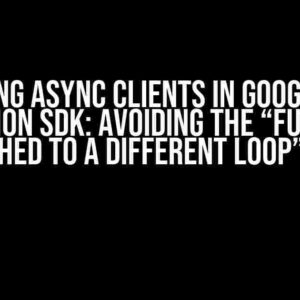Welcome to the world of asyncio, where asynchronous programming meets Python! In this article, we’ll dive into one of the most common pitfalls that new asyncio users fall into: calling run() twice in the same function. Buckle up, folks, as we explore the reasons behind this limitation and provide you with a clear understanding of how to overcome it.
The Problem: Calling run() Twice
Imagine you’re building an asynchronous application using asyncio, and you want to run two separate tasks concurrently. You might be tempted to write code like this:
import asyncio
async def task1():
print("Task 1 started")
await asyncio.sleep(2)
print("Task 1 finished")
async def task2():
print("Task 2 started")
await asyncio.sleep(1)
print("Task 2 finished")
def main():
asyncio.run(task1())
asyncio.run(task2())
asyncio.gather(main())At first glance, this code seems reasonable. You’re calling run() twice, once for each task, to execute them concurrently. However, when you run this code, you’ll encounter an error:
RuntimeError: Cannot run the event loop while another loop is runningWhat’s Going On?
The issue lies in how asyncio’s event loop works. When you call asyncio.run(), it creates a new event loop and runs it until the task completes. However, once an event loop is running, it becomes the only active loop in the program. Attempting to create a new event loop while one is already running results in the error you saw above.
So, why can’t you call run() twice in the same function? The answer is simple: it’s because asyncio’s design doesn’t allow for multiple concurrent event loops in the same thread.
The Solution: Using a Single Event Loop
To overcome this limitation, you need to use a single event loop to run all your tasks concurrently. One way to do this is by using asyncio.gather(), which allows you to run multiple tasks simultaneously:
import asyncio
async def task1():
print("Task 1 started")
await asyncio.sleep(2)
print("Task 1 finished")
async def task2():
print("Task 2 started")
await asyncio.sleep(1)
print("Task 2 finished")
async def main():
await asyncio.gather(task1(), task2())
asyncio.run(main())In this revised code, we define an async def main() function that uses asyncio.gather() to run both tasks concurrently. We then call asyncio.run() only once, passing in the main() function. This allows both tasks to share the same event loop and run simultaneously.
Other Ways to Run Tasks Concurrently
Besides asyncio.gather(), there are other ways to run tasks concurrently using asyncio:
asyncio.create_task(): Creates a task object that can be scheduled to run concurrently.asyncio.wait(): Waits for the completion of multiple tasks and returns the results.asyncio.as_completed(): Returns an iterator that yields tasks as they complete.
Each of these methods allows you to run tasks concurrently, but they have different use cases and semantics. Be sure to check the asyncio documentation for more information on how to use them effectively.
Best Practices for Asyncio Development
To avoid common pitfalls and make the most of asyncio, follow these best practices:
- Use a single event loop per thread: asyncio is designed to work with a single event loop per thread. Avoid creating multiple event loops or calling
run()multiple times in the same function. - Use asyncio.gather() for concurrent tasks: When you need to run multiple tasks concurrently, use
asyncio.gather()to simplify your code and ensure tasks are run efficiently. - Avoid blocking code in async functions: Blocking code can prevent other tasks from running and cause performance issues. Use asyncio’s built-in features, such as
asyncio.sleep(), to write efficient asynchronous code. - Test your code thoroughly: Asynchronous code can be tricky to debug. Make sure to test your code extensively to catch any errors or unexpected behavior.
By following these best practices, you’ll be well on your way to writing efficient, concurrent, and scalable asyncio applications.
Common Pitfalls and Troubleshooting
When working with asyncio, it’s easy to fall into common pitfalls. Here are some troubleshooting tips to help you overcome common issues:
| Error | Cause | Solution |
|---|---|---|
| RuntimeError: Cannot run the event loop while another loop is running | Calling asyncio.run() multiple times in the same function |
Use a single event loop per thread and call asyncio.run() only once |
| Task never completes | Blocking code in async function | Avoid blocking code and use asyncio’s built-in features, such as asyncio.sleep(), instead |
| Unexpected behavior or errors | Incorrect usage of asyncio features | Check the asyncio documentation and ensure correct usage of features, such as asyncio.gather() and asyncio.create_task() |
By being aware of these common pitfalls and following best practices, you’ll be able to write robust, efficient, and concurrent asyncio applications.
Conclusion
In this article, we’ve explored the reasons why you can’t call asyncio.run() twice in the same function and provided solutions for running tasks concurrently using asyncio. By following best practices and avoiding common pitfalls, you’ll be able to unlock the full potential of asyncio and write scalable, concurrent applications.
Remember, asyncio is a powerful tool, but it requires careful understanding and usage to achieve optimal results. With practice and patience, you’ll become proficient in writing efficient and concurrent asyncio code.
Happy coding!
Frequently Asked Question
Get the lowdown on asyncio’s run function and why it’s not meant to be called twice in the same function.
Why does calling run() twice in the same function throw an error?
That’s because the run() function is meant to be the entry point for asyncio’s event loop. When you call run() for the first time, it sets up the event loop and starts running it. If you try to call run() again, it’ll throw an error because the event loop is already running! Think of it like trying to start a car that’s already moving – it just won’t work.
Is there a way to reset asyncio’s event loop?
Sorry, buddy! Once the event loop is running, you can’t reset it or call run() again. asyncio’s design is meant to prevent this kind of behavior. If you need to perform multiple tasks concurrently, you can use the await keyword or create multiple tasks using the create_task() function. That way, you can keep your event loop running smoothly!
What if I need to call an asynchronous function multiple times?
No problemo! You can call an asynchronous function multiple times using the await keyword. For example, if you have an async function called my_async_func(), you can call it multiple times like this: await my_async_func() and then await my_async_func() again. Each call will run concurrently, and you won’t need to call run() again. Easy peasy!
Can I use multiple event loops in the same program?
Yes, you can! But be careful, because it’s not always the best idea. Having multiple event loops can lead to complexity and make your code harder to debug. In general, it’s better to use a single event loop and create multiple tasks within it. If you really need multiple event loops, make sure you understand the implications and use them wisely.
What’s the best way to structure my asyncio code?
To write awesome asyncio code, keep it simple and structured. Create a main() function that sets up your event loop and calls your asynchronous functions. Use the await keyword to call your async functions, and consider using try-except blocks to catch any errors. Keep your code organized, and you’ll be asyncio-ing like a pro in no time!


